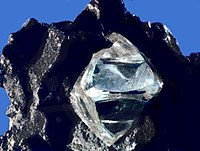
Photo from wikipedia
Abstract Much of the world's economic copper resources are hosted in porphyry copper deposits (PCDs), shallow level magmatic intrusions associated mostly with thick ( > 45 km ) magmatic arcs,… Click to show full abstract
Abstract Much of the world's economic copper resources are hosted in porphyry copper deposits (PCDs), shallow level magmatic intrusions associated mostly with thick ( > 45 km ) magmatic arcs, such as mature island arcs and continental arcs. However, a well-known, but unresolved paradox, is that arc magmas traversing thick crust, particularly in continental arcs, are generally depleted in Cu whereas in island arcs, where PCDs are less common, magmas become enriched in Cu. Here, we show that the formation of PCDs requires a complex sequence of intra-crustal magmatic processes, from the lower crust to the upper crust. PCDs form when the crust becomes thick ( > 45 km ) enough to crystallize garnet. Garnet fractionation depletes Fe from the magma, which drives sulfide segregation and removal of most of the magma's Cu into the lower crust, leaving only small amounts of Cu in the residual magma to make PCDs. However, because garnet is depleted in ferric iron, the remaining Fe in the magma becomes progressively oxidized, which eventually oxidizes sulfide to sulfate, thereby releasing sulfide bound Cu from the magma into solution. This auto-oxidation of the magma, made possible by deep-seated garnet fractionation, increases the ability of endogenic magmatic fluids to self-scavenge Cu from large volumes of otherwise Cu-poor magmas and then transport and concentrate Cu to the tops of magmatic bodies. Examination of the occurrence of PCDs in the central Andes shows that ore formation occurs when continental arcs reach their maximum thickness ( > 60 km ), just before the termination of magmatism.
Journal Title: Earth and Planetary Science Letters
Year Published: 2020
Link to full text (if available)
Share on Social Media: Sign Up to like & get
recommendations!